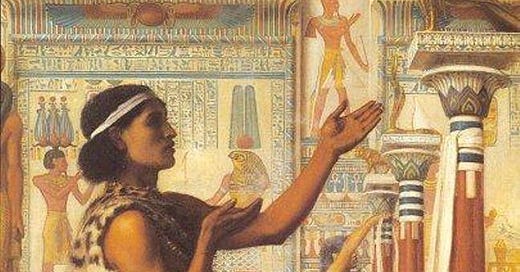The “introit” refers to the introductory rites, usually in a Catholic context, but the word makes a useful shorthand term regardless. It is here where the participants make their appearance, accompanied by hymns of praise and purification of those in attendance.
In our prior installations about our temple liturgy, we covered the inner sanctuary rite of Edfu. It’s own “introit” consists of the initial entry, unsealing the doors to the shrine, opening the shrine to reveal the statue of the deity, and praising the deity. However, this would have been preceded by a much lengthier set of rituals outside the inner sanctum. The officiant (Pharaoh or priest) was purified with water, natron and incense, then a series of hymns to Horus were recited as the priest and his entourage made their way to the inner temple. At the doors of the pronaos, they would have recited a series of attestations regarding their physical and moral preparedness to see the God. These “declarations of innocence” against lying, theft, and such are similar to those we see in the Book of the Dead (which likely were descended from temple declarations), and a more truncated form in the Book of Breathings.
Meanwhile, other priests were busy with their own “introits”: some would be drawing and consecrating the water used in the aforementioned purification. Others would bring the offerings from the kitchens into the temple with their associated consecrations. Then as the doors to the sanctuary were opened, the priests recited the morning litany as the head priest performed the sanctuary rite proper.
These daily introits were complemented by similar introits for festivals. The one we use in the Temple of Horus on the Prairie come from the temple dedication ceremony. It is a more compact set of rites, more succinct; it is followed by “seeing the God”, prostration, and most importantly the profound Father of Fathers hymn we love so much (all of which I will cover in a later post). Here is that introit, with Chassinat notation in parenthesis:
(Approach temple) I come out of the hall to get to the seat of Ra and bend my arm in front of Horus. The mace and scepter are firm in my hands and they illuminate the temple of the supreme ruler of the Gods. Come, you standard-bearing Gods, open my way to the house of the Horus of the Horus Gods. No adversary crosses my path, because these guardian Gods are my protection. (E VII 42, 8-14)
This is traditionally said by the Pharaoh (especially for a temple dedication), but priests would serve as delegates. Either way, the head officiant should be reciting this, while holding the two implements mentioned. The mace can be any wooden club (I use a small Indian club used for exercise) but I would say you can use a staff in a pinch since we also see it paired with the scepter. As for the scepter itself, it was likely a kherep or sekhem, which looked like a small spatula. An example of an official holding staff and scepter can be found here.
(First asperging of priest and participants) I clean (your/my) image with this water from Lake of Horus so that it is pure, as the earth is pure for Geb. (E VII 191, 5-6)
In this scene, the Pharaoh (or priest stand-in) is purified by officiants representing Horus and Thoth. The oft-repeated scene shows these two Gods (or people playing their role) pouring water over the Pharaoh. You can actually pour water over the priest, or sprinkle it. If you are doing the rite solo, use the “my” phrase rather than “your”. This utterance links the purification of the officiant with the purification of the earth for the deity of the earth, Geb.
(Second asperging of priest and participants) I purify (your/my) form with this water from the canal so that it is pure, as the sky is pure for Ra. (E VII 191, 5-9)
If there is only one other participant, he can recite this prayer and the prior one. Otherwise have someone else do this one. It forms the compliment to the first, this time referencing the solar-creator God Ra (who by the time of Edfu was combined with Horus) and the purification of the sky, so the officiant is purified in both heaven and earth.
After both purifications, the Pharaoh would be crowned with a uraeus crown, a circlet with the image of a cobra in the front. There was no utterance associated with this action for this particular festival. You can consider it optional if you can’t source a crown, although they are not difficult to find through online artisans or even costume shops.
(First Induction) The house of the falcon breaks out in jubilation to receive you; enter the sanctuary of the winged disk in joy. (E VII 192, 2)
(Second Induction) Come in peace, your ways are safe, and my heart rejoices in your sight. (E VII 192, 7)
(Third Induction) Welcome, welcome, because Horus who Unites the Two Lands leads you to the Great Throne and opens the way for you. (E VII 192, 9)
The three proclamations above followed the crowning, where the officiant and his entourage were greeted by the Gods. Again, you can recite all of these if you’re doing alone, or alternate among those present. The first proclamation is said by Horus Who Unites the Two Lands, the aspect of Horus who is the son of Horus of Edfu and Hathor; the second is said by Horus of Edfu himself, and the third by His consort Hathor (who was also identified with Ma’at). Thus the “holy trinity” of the Edfu temple welcomes and rejoices at the meeting of Gods and men.



